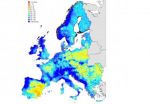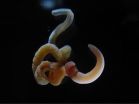(Press-News.org) WASHINGTON, March 14, 2012 — The latest episode in the American Chemical Society's (ACS) award-winning "Global Challenges/Chemistry Solutions" podcast series describes the development of a new test that could help track down and prosecute terrorists.
Amid concerns about the threat of terrorist attacks, scientists have been seeking better protection for the U.S. and other nations. One such team has developed a technique that could help authorities catch terrorists and put them out of business. A report on the development appeared in ACS' journal Analytical Chemistry, and became the topic of the new podcast.
Nerve agents like sarin, or GB, are some of the most dangerous terrorist threats. Although traces of these substances would remain after an attack, there has been no practical way of tracing the remains backward in time — to the company from which they were purchased or possibly to the terrorists who bought them.
In the podcast, Carlos Fraga, Ph.D., of Pacific Northwest National Laboratory, Richland, Wash., explains that his team has developed a first-of-its-kind technology that could help law enforcement officials trace the residues from terrorist attacks involving nerve gas and other chemical agents back to the companies or other sources from which the perpetrators obtained ingredients for the agent.
The researchers used a method called "impurity profiling" that identifies impurities in a GB sample at a crime scene and matches them like a fingerprint to the impurities in the source chemicals, pinpointing the likely source. They found that up to 88 percent of the impurities in source chemicals used to make GB can wind up in the finished product, and these impurities are unique, like a fingerprint.
So exactly how would these "fingerprints" help the FBI, police and other federal law enforcement officials? Using standard laboratory instruments, the scientists did impurity profiling and correctly identified the starting materials used for two different batches of GB. This may one day become a basis for using impurity profiling to help find and prosecute perpetrators of chemical attacks, says Fraga.
The new podcast is available without charge at iTunes and from www.acs.org/globalchallenges.
###
Global Challenges/Chemistry Solutions is a series of podcasts describing some of the 21st century's most daunting problems, and how cutting-edge research in chemistry matters in the quest for solutions. Global Challenges is the centerpiece in an alliance on sustainability between ACS and the Royal Society of Chemistry. Global Challenges is a sweeping panorama of global challenges that includes dilemmas such as providing a hungry, thirsty world with ample supplies of safe food and clean water; developing alternatives to petroleum to fuel society; preserving the environment and assuring a sustainable future for our children and improving human health.
For more entertaining, informative science videos and podcasts from the ACS Office of Public Affairs, view Prized Science, Spellbound, Science Elements and Global Challenges/Chemistry Solutions.
The American Chemical Society is a nonprofit organization chartered by the U.S. Congress. With more than 164,000 members, ACS is the world's largest scientific society and a global leader in providing access to chemistry-related research through its multiple databases, peer-reviewed journals and scientific conferences. Its main offices are in Washington, D.C., and Columbus, Ohio.
To automatically receive news releases from the American Chemical Society contact newsroom@acs.org.
END
Scientists at Johannes Gutenberg University Mainz (JGU) in Germany have developed a new method of observing individual proteins. Detailed knowledge of the dynamics of proteins is necessary in order to understand the related biological processes that occur on the molecular level. To date, this information has been obtained by means of labeling proteins with fluorescent substances, but unfortunately this changes the proteins under investigation and thus influences the biological processes that are to be observed. "Our method allows live tracking of individual proteins without ...
The reputation developed by Jamaica Blue Mountain Coffee has made it one of the most desirable and expensive coffees in the world. Blue Mountain coffee from Jamaica is known to have a mild and balanced flavor and lack the bitterness often found in lesser coffees. J. Martinez & Company is one of few companies given the right to import Jamaica Blue Mountain coffee.
Blue Mountain Coffee is protected by a global certification mark, meaning that steps have been taken to ensure that only authentic Blue Mountain coffee, grown in a specific region of the Blue Mountains of ...
A new assessment of available water resources, published today by the Joint Research Centre (JRC), reveals that large areas in Spain and Eastern Europe have on average less than 200 mm freshwater available every year while the demand for water is three to ten times higher. The report 'Current Water Resources in Europe and Africa' shows variations in yearly freshwater generation from 10 mm to over 500 mm for Europe and from less than 0.1 mm to over 500 mm for Africa. The report outlines existing uncertainties and points to further research efforts needed for improved water ...
CORAL GABLES, FL (March 14, 2012)--Convincing speeches are central to campaigning for elected office, but do our voices affect how we select our leaders? A newly-published paper in Proceedings of the Royal Society B: Biological Sciences shows that men and women vote for male and female candidates with lower-pitched voices. Men and women with lower voices were also found to be perceived as more competent, stronger, and more trustworthy. Each of these attributes is known to influence voters.
"Our study asks how voice pitch influences electability, and to my knowledge is ...
NEW YORK (March 14, 2012) -- Nationwide ambulance use by patients suffering from a stroke has not changed since the mid-1990s, even though effective stroke treatments are now available. In a study published in this week's Journal of the American Medical Association (JAMA), researchers at NewYork-Presbyterian Hospital/Weill Cornell Medical Center found that the number of stroke victims transported via ambulance has remained relatively static over the years, highlighting the need for more education about stroke symptoms and the importance of early intervention.
The study, ...
WOODS HOLE, MA—The origin of the exquisitely complex vertebrate brain is somewhat mysterious. "In terms of evolution, it basically pops up out of nowhere. You don't see anything anatomically like it in other animals," says Ariel Pani, an investigator at the Marine Biological Laboratory (MBL) in Woods Hole and a graduate student at the University of Chicago.
But this week in the journal Nature, Pani and colleagues report finding some of the genetic processes that regulate vertebrate brain development in (of all places) the acorn worm, a brainless, burrowing marine invertebrate ...
MAYWOOD, Il. -- A Loyola University Chicago Stritch School of Medicine study has revealed details of the complex molecular process involving a protein that enables cancer cells to establish tumors in distant parts of the body.
The finding could lead the way to new drugs to prevent breast cancer and other cancers from spreading to new sites.
The study by Adriano Marchese, PhD and colleagues is published in the March 16 issue of the Journal of Biological Chemistry, and is now available online.
The study involves a molecule on the surface of cells called CXCR4. There is ...
COLUMBUS, Ohio – Researchers have designed a new version of a labor-tracking tool for pregnant women that they predict could reduce the use of hormonal intervention during labor and lower the number of cesarean sections performed on low-risk, first-time mothers.
The tool, called a partograph, takes into account the most recent research findings that suggest labor is not a linear process, but is instead slower during earlier labor and accelerates gradually as labor advances. A diagnosis of abnormally slow labor is the No. 1 reason that C-sections are performed in low-risk ...
I&K International has announced a significant increase in sales of products from its men's range. The surge in sales is believed to have been a direct result of the addition of new men's products over the last few years, as well as a general increase in the amount of attention men are paying to grooming.
Indeed, the company has saw a 60% rise in the number of men buying these products when compared to the same time last year. These figures would seem to indicate that men are paying more attention to their physical appearance and grooming than ever before, and Kevin ...
For 300 million years, Earth's oceans teemed with conodonts – early vertebrates that kept their skeleton in their mouth. The elements of this skeleton look uncannily like teeth (see image) and, like teeth, they were often worn and broken during life. This evidence strongly suggests that conodonts evolved the first vertebrate dentitions.
Scientists know that conodont elements worked differently from the teeth of other animals: they are microscopic – about 2 to 0.2 mm long – and must have had paltry muscles to move them, with no jaws to which they could attach. So how ...

